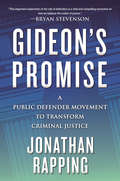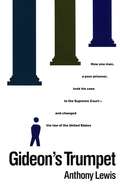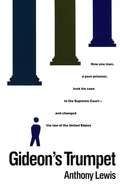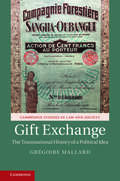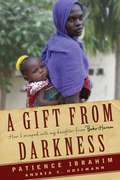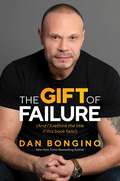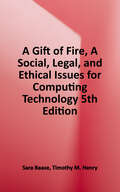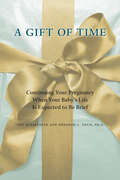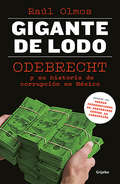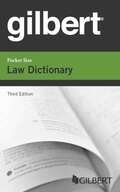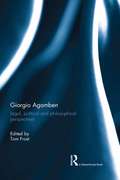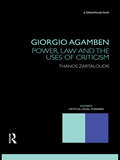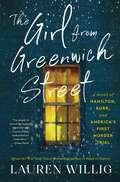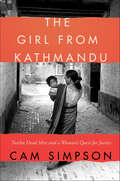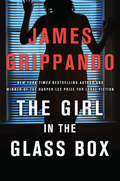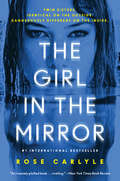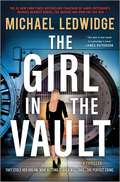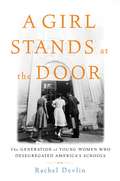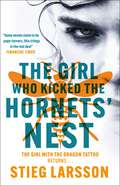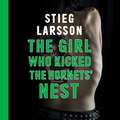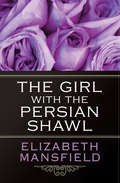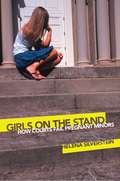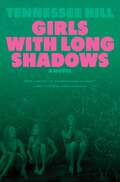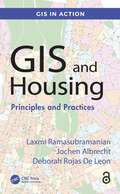- Table View
- List View
Gideon's Promise: A Public Defender Movement to Transform Criminal Justice
by Jonathan RappingA blueprint for criminal justice reform that puts a new generation of public defenders front and center in the fight for legal equalityCombining wisdom drawn from over a dozen years as a public defender and cutting-edge research in the fields of organizational and cultural psychology, Jonathan Rapping reveals the pervasive issues inherent in our current system of public defense, and lays the foundation for how model public defense programs should work to end mass incarceration. Public defenders represent over eighty percent of those who interact with the court system, a disproportionate number of whom are poor, non-white citizens who rely on them to navigate the law on their behalf. More often than not, even the most well-meaning of those defenders are over-worked, under-funded, and incentivized to put the interests of judges and politicians above those of their clients in a culture that beats the passion out of talented, driven advocates, and has led to an embarrassingly low standard of justice for those who depend on the promises of Gideon v. Wainwright.However, rather than arguing for a change in rules that govern the actions of lawyers, judges, and other advocates, Rapping proposes a radical cultural shift to a "fiercely client-based ethos" driven by values-based recruitment and training, awakening defenders to their role in upholding an unjust status quo, and a renewed pride in the essential role of moral lawyering in a democratic society.Through the story of founding Gideon's Promise and anecdotes of his time as a defender and teacher, Rapping reanimates the possibility of public defenders serving as a radical bulwark against government oppression and a megaphone to amplify the voices of those they serve.
Gideon's Trumpet
by Anthony LewisA history of the landmark case of James Earl Gideon's fight for the right to legal counsel. Notes, table of cases, index. The classic backlist bestseller. More than 800,000 sold since its first pub date of 1964.From the Trade Paperback edition.
Gideon's Trumpet
by Anthony R. LewisRecounts the true story of a prisoner who went to the supreme court in order to insure his right to legal representation.
Gift Exchange: The Transnational History of a Political Idea (Cambridge Studies in Law and Society)
by Grégoire MallardSince Marcel Mauss published his foundational essay The Gift in 1925, many anthropologists and specialists of international relations have seen in the exchange of gifts, debts, loans, concessions or reparations the sources of international solidarity and international law. Still, Mauss's reflections were deeply tied to the context of interwar Europe and the French colonial expansion. Their normative dimension has been profoundly questioned after the age of decolonization. A century after Mauss, we may ask: what is the relevance of his ideas on gift exchanges and international solidarity? By tracing how Mauss's theoretical and normative ideas inspired prominent thinkers and government officials in France and Algeria, from Pierre Bourdieu to Mohammed Bedjaoui, Grégoire Mallard adds a building block to our comprehension of the role that anthropology, international law, and economics have played in shaping international economic governance from the age of European colonization to the latest European debt crisis. This title is also available as Open Access on Cambridge Core.
A Gift from Darkness
by Andrea Claudia Hoffmann Patience IbrahimThe inspirational story of a pregnant young Nigerian woman and the horrors she endured to save her unborn child when she was kidnapped by Boko Haram.When she was nineteen, Patience Ibrahim's first husband was murdered by Boko Haram. She fled to the safety of her village and remarried several months later. Having prayed for a child for years, Patience is overjoyed when she discovers she is pregnant. But her joy is short-lived: Boko Haram soldiers are at her door. Brutally abducted and forced to convert to Islam, she lives in constant terror of what her kidnappers have in store for her. She finds herself alone in the world and fears her life is over. For two months, Patience hides her pregnancy while facing the brutalities meted out by Boko Haram. By the sheer force of her determination to protect her baby, she and her child are able to survive. Now, she has entrusted journalist Andrea C. Hoffmann with her story, a powerful first-person account of Boko Haram's atrocities in Nigeria and Cameroon.One of the first testimonies on the terrorist group's war crimes in Western Africa, A Gift from Darkness poignantly shows the human toll of a crisis that demands attention.
The Gift of Failure: (And I'll rethink the title if this book fails!)
by Dan BonginoDan Bongino&’s brutally honest, deeply personal, unforgettable stories about how he transformed failures into victories will enthrall, entertain, and inspire readers.In The Gift of Failure, leading conservative commentator Dan Bongino identifies failures in his life and how those failures led to bigger and better things. With the same laser-focused intensity that has made him one of America&’s most popular voices, Bongino uncompromisingly cuts to the heart of failure with a collection that is inspirational, motivational, entertaining, touching, and redemptive. The former Secret Service agent currently hosts one of the country&’s most listened to radio programs along with a top-rated podcast and the popular Fox News television show, Unfiltered. Throughout his career, Bongino has helped trailblaze a fight for free speech and free expression, garnering many national headlines for taking on some of the biggest tech companies in the world to challenge their seemingly draconian censorship policies. Along the way, through his many David vs. Goliath battles, Bongino has learned the hard way why failure matters. In The Gift of Failure, he shares, in vivid detail, many of these experiences—from high-profile, front-page stories involving the drama behind Parler and Rumble, to never-before-shared personal tales covering his childhood, the Secret Service, the media, a recent serious health battle, and much more. Bongino&’s vulnerability coupled with his trademark in-your-face, unapologetic honesty and humor help illuminate many life lessons. This is unforgettable storytelling as only Bongino can deliver. Whether you agree with him or not, there&’s something here for everyone.
A Gift of Fire: Social, Legal, and Ethical Issues for Computing Technology
by Sara Baase Timothy M. HenryFor courses in Computer Ethics and Computers and Society. An objective study of technology ethics that inspires critical thinking and debate, <p><p> In Gift of Fire, A: Social, Legal, and Ethical Issues for Computing Technology, Sara Baase presents a balanced exploration of the social, legal, philosophical, ethical, political, constitutional, and economic implications of computing and the controversies they raise. With an objective computer scientist's perspective, and with historical context for many issues, Baase covers the issues readers will face both as members of a technological society and as professionals in computer-related fields. A primary goal is to develop computer professionals who understand the implications of what they create and how it fits into society at large. This text encourages readers to think about the ethics and philosophical direction behind topics but doesn't lead students to conclusions. <p><p>The 5th Edition contains updated material on new topics and examples, outdated material has been removed, and several topics have been reorganized. New material appears throughout, including material on current trending topics such as drones and autonomous cars.
A Gift of Time: Continuing Your Pregnancy When Your Baby's Life Is Expected to Be Brief
by Amy Kuebelbeck Deborah L. DavisA Gift of Time is a gentle and practical guide for parents who decide to continue their pregnancy knowing that their baby's life will be brief. When prenatal testing reveals that an unborn child is expected to die before or shortly after birth, some parents will choose to proceed with the pregnancy and to welcome their child into the world. With compassion and support, A Gift of Time walks them step-by-step through this challenging and emotional experience—from the infant's life-limiting prenatal diagnosis and the decision to have the baby to coping with the pregnancy and making plans for the baby’s birth and death. A Gift of Time also offers inspiration and reassurance through the memories of numerous parents who have loved a child who did not survive. Their moving experiences are stories of grief—and of hope. Their anguish over the prenatal diagnosis turns to joy and love during the birth of their child and to gratitude and peace when reflecting on their baby’s short life.Full of practical suggestions for parents and for caregivers, A Gift of Time also features the innovative concept of perinatal hospice and palliative care. Caring and thoughtful, the book helps parents embrace the extraordinary time they will have with their child.
Gigante de lodo: Odebrecht y su historia de corrupción en México
by Raúl OlmosElecciones compradas, sobornos, lavado de dinero y un paraíso de impunidad en México. En la víspera de que Enrique Peña Nieto asumiera la Presidencia de la República, el departamento de sobornos de la trasnacional brasileña Odebrecht transfirió casi un millón de dólares a una cuenta ligada a uno de los hombres más cercanos al entonces mandatario electo. Y justo un día después de una cita entre Peña Nieto y Marcelo Odebrecht, presidente del emporio, se realizó una de las transferencias ilícitas. ¿Aquello fue una simple coincidencia o una acción concertada? Este libro muestra la sincronía casi perfecta entre los sobornos -en total, más de 16 millones de dólares desde 2009- y la entrega de contratos multimillonarios a Odebrecht en México. Contra lo que muchos creen, el poder corruptor del consorcio brasileño no se restringió a Petróleos Mexicanos o al gobierno federal. Políticos de primer nivel de otros partidos también estuvieron en contacto con el brazo corruptor de esa trasnacional. Gigante de lodo, en suma, es el libro clave para entender a profundidad la mayor trama de corrupción en la historia del continente, que en México permanece prácticamente impune.
Gilbert Pocket Size Law Dictionary
by Publisher'S Editorial StaffThe entries in the Gilbert Law Dictionary encompass the most common words and definitions in the legal vocabulary. The Dictionary is designed as a portable reference guide, abridged for convenience and facility. With this book in hand, you should soon come to understand the language of law.
Giorgio Agamben: Legal, Political and Philosophical Perspectives
by Tom FrostThis book collects new contributions from an international group of leading scholars – including many who have worked closely with Agamben – to consider the impact of Agamben’s thought on research in the humanities and social sciences. Giorgio Agamben: Legal, Political and Philosophical Perspectives addresses the potential of Agamben’s thought by re-focusing attention away from his critiques of Western politics and towards his scheme for a political future. Part I of the book draws upon a wide range of issues such as legal oaths, legal reasoning and Christian conceptions of love in order to examine the potential for Agamben’s work to impact upon future legal scholarship. Part II focuses on political perspectives that include references to Marx, Rousseau and Agamben’s conception of the ‘messianic’. Theology, biology, and the thought of Gilles Deleuze, Walter Benjamin and Antonin Artaud are all drawn upon in Part III to explore philosophical perspectives in Agamben’s thought. This book demonstrates the importance and originality of Giorgio Agamben, who has articulated a vision of politics that must be recognised as an influential contribution to modern philosophical and political thinking. It is a book that will be of considerable interest to many working across the humanities and social sciences.
Giorgio Agamben: Power, Law and the Uses of Criticism (Nomikoi: Critical Legal Thinkers)
by Thanos ZartaloudisGiorgio Agamben: Power, Law and the Uses of Criticism is a thorough engagement with the thought of the influential Italian philosopher Giorgio Agamben. It explores Agamben’s work on language, ontology, power, law and criticism from the 1970s to his most recent publications. Introducing Agamben's work to a readership in legal theory, as well as in the humanities and social sciences more generally, Thanos Zartaloudis argues that an adequate understanding of Agamben's Homo Sacer project requires an attention to his earlier philosophical writings on language, ontology, power and time. It is through this attentive and creative analysis of Agamben's work that Zartaloudis here presents a rethinking of the ideas of justice and criticism.
The Girl from Berlin: A Novel (Liam Taggart and Catherine Lockhart #5)
by Ronald H. BalsonIn the newest novel from internationally-bestselling author Ronald. H. Balson, Liam and Catherine come to the aid of an old friend and are drawn into a property dispute in Tuscany that unearths long-buried secretsAn old friend calls Catherine Lockhart and Liam Taggart to his famous Italian restaurant to enlist their help. His aunt is being evicted from her home in the Tuscan hills by a powerful corporation claiming they own the deeds, even though she can produce her own set of deeds to her land. Catherine and Liam’s only clue is a bound handwritten manuscript, entirely in German, and hidden in its pages is a story long-forgotten…Ada Baumgarten was born in Berlin in 1918, at the end of the war. The daughter of an accomplished first-chair violinist in the prestigious Berlin Philharmonic, and herself a violin prodigy, Ada’s life was full of the rich culture of Berlin’s interwar society. She formed a deep attachment to her childhood friend Kurt, but they were torn apart by the growing unrest as her Jewish family came under suspicion. As the tides of history turned, it was her extraordinary talent that would carry her through an unraveling society turned to war, and make her a target even as it saved her, allowing her to move to Bologna—though Italy was not the haven her family had hoped, and further heartache awaited.What became of Ada? How is she connected to the conflicting land deeds of a small Italian villa? As they dig through the layers of lies, corruption, and human evil, Catherine and Liam uncover an unfinished story of heart, redemption, and hope—the ending of which is yet to be written.Don't miss Liam and Catherine's lastest adventures in The Girl from Berlin!
The Girl from Greenwich Street: A Novel of Hamilton, Burr, and America's First Murder Trial
by Lauren WilligBased on the true story of a famous trial, this novel is Law and Order: 1800, as Alexander Hamilton and Aaron Burr investigate the shocking murder of a young woman who everyone—and no one—seemed to know.At the start of a new century, a shocking murder transfixes Manhattan, forcing bitter rivals Alexander Hamilton and Aaron Burr to work together to save a man from the gallows. Just before Christmas 1799, Elma Sands slips out of her Quaker cousin’s boarding house—and doesn’t come home. Has she eloped? Run away? No one knows—until her body appears in the Manhattan Well.Her family insists they know who killed her. Handbills circulate around the city accusing a carpenter named Levi Weeks of seducing and murdering Elma. But privately, quietly, Levi’s wealthy brother calls in a special favor….Aaron Burr’s legal practice can’t finance both his expensive tastes and his ambition to win the 1800 New York elections. To defend Levi Weeks is a double win: a hefty fee plus a chance to grab headlines.Alexander Hamilton has his own political aspirations; he isn’t going to let Burr monopolize the public’s attention. If Burr is defending Levi Weeks, then Hamilton will too. As the trial and the election draw near, Burr and Hamilton race against time to save a man’s life—and destroy each other.Part murder mystery, part thriller, part true crime, The Girl From Greenwich Street revisits a dark corner of history—with a surprising twist ending that reveals the true story of the woman at the center of the tale.
The Girl from Kathmandu: Twelve Dead Men and a Woman's Quest for Justice
by Cam SimpsonNew York Times Book Review Editor's ChoiceThe shocking story of the massacre of a group of Nepalese men working as Defense contractors for the United States Government during the Iraq War, and the widow who dedicated her life to finding justice for her husband and the other victims—a riveting tale of courageous heroes, corporate war profiteers, international business, exploitation, trafficking, and human rights in the age of global capitalism that reveals how modern power truly works.In August of 2004, twelve men left their village in Nepal for jobs at a five-star luxury hotel in Amman, Jordan. They had no idea that they had actually been hired for sub-contract work on an American military base in Iraq. But fate took an even darker turn when the dozen men were kidnapped and murdered by Islamic extremists. Their gruesome deaths were captured in one of the first graphic execution videos disseminated on the web—the largest massacre of contractors during the war. Compounding the tragedy, their deaths received little notice.Why were these men, from a remote country far removed from the war, in Iraq? How had they gotten there? Who were they working for? Consumed by these questions, award-winning investigative journalist Cam Simpson embarked on a journey to find answers, a decade-long odyssey that would uncover a web of evil spanning the globe—and trigger a chain of events involving one brave young widow, three indefatigable human rights lawyers, and a formidable multinational corporation with deep governmental ties.A heart-rending, page-turning narrative that moves from the Himalayas to the Middle East to Houston and culminates in an epic court battle, The Girl from Kathmandu is a story of death and life—of the war in Iraq, the killings of the twelve Nepalese, a journalist determined to uncover the truth, and a trio of human rights lawyers dedicated to finding justice. At its heart is one unforgettable young woman, Kamala Magar, who found the courage to face the influential men who sent her husband to his death—a model of strength hope, bravery, and an unbreakable spirit who reminds us of the power we all have to make a difference.
The Girl in the Glass Box: A Jack Swyteck Novel (Jack Swyteck Novel #15)
by James GrippandoMiami attorney Jack Swyteck lands in the heart of the contentious immigration debate when he takes on the heart-wrenching case of an undocumented immigrant who fled to America to protect her daughter and save herself, in this timely and pulse-pounding thriller that explores the stories behind the headlines from New York Times bestselling author James Grippando, winner of the Harper Lee Prize for Legal Fiction.Julia Rodriguez and her teenage daughter Beatriz escaped bloodthirsty gangs, random violence and, Julia's abusive husband back in El Salvador. Arriving in Miami, mother and daughter struggled to carve their own piece of the American dream. While life in the States is hard, it is safer, until Julia's rejects her boss's unwanted sexual advances. Suddenly—thanks to an "anonymous" tip to U. S. immigration authorities—she is arrested, locked in detention with criminals, and slated for deportation. Jack's only viable legal move to save her is asylum—a long shot that’s become nearly impossible in today’s charged political climate.When Julia and Beatriz made the perilous trek north to freedom, they thought they’d left the danger behind them. But now, even Miami isn’t safe. A ruthless enemy may have tracked them to south Florida and is biding time, patiently waiting to strike. In a case where the stakes have never been higher, Jack Sywteck may not be able to save his client—even if he wins.
The Girl in the Mirror: A Novel
by Rose CarlyleInstant #1 International Bestseller“Cue greed, lust, secrets, and serious suspense. Count us in.”—theSkimm"An insanely plotted book...riveting."—The New York Times Book ReviewWritten with the chilling, twisty suspense of The Wife Between Us and Something in the Water, a seductive thriller about identical twins, greed, lust, secrets, and deadly lies.Twin sisters Iris and Summer are startlingly alike, but beyond what the eye can see lies a darkness that sets them apart. Cynical and insecure, Iris has long been envious of Summer’s seemingly never-ending good fortune.When Summer calls Iris to Thailand to help her sail the family yacht to the Seychelles, Iris has secret hopes for what might happen on the journey. But after a disturbing incident in the middle of the Indian Ocean, everything changes.Now Iris has the chance to step into the golden life she’s always envied–and get one step closer to the hundred-million-dollar inheritance left by her manipulative father. All Iris would need to do is ensure she’s the first of his seven children to fulfill the strange conditions of his will.But Iris soon discovers that her twin was keeping more than one secret, and Iris’s life lurches between glamorous dream and paranoid nightmare. In a family in which the winner takes all, whom can she trust? And how far will she go to get the life she’s always dreamed about?"Ferociously entertaining. A novel like a triathlon: part evil-twin thriller, part howdunit (or did-she-do-it?), part juicy family drama. Drop Knives Out and Double Indemnity into the blender, shake some Dead Calm over the froth, power it on, and you’ve got a cocktail like The Girl in the Mirror—fresh, flavorful, and utterly intoxicating." —AJ Finn, #1 New York Times bestselling author of The Woman in the Window
The Girl in the Vault: A Thriller
by Michael Ledwidge"The Girl in the Vault is Ledwidge's best."—James PattersonThey stole her dream.Now getting it back will take…The perfect crime.It&’s summer in New York City and Faye Walker has it all. She&’s not only scored one of the most highly coveted internships in all of Wall Street, she&’s also just met the head-over-heels love of her life. With her natural-born gift for numbers and a work ethic that knows no bounds, Faye is a shoo-in for a full-time position at the illustrious merchant bank Greene Brothers Hale. Then, just as she awaits her offer and her signing bonus, a treacherous betrayal arrives to shatter Faye&’s plans and her young life.But what her high finance masters-of-the-universe bosses don&’t know is that Faye isn&’t like any of the other interns. Having made her way past her humble small-town beginnings, for Faye, going back is not an option. That&’s why Faye now has a new plan. One that involves Swiss watch timing, nerves of steel and ten million dollars in cold hard Wall Street cash.
A Girl Stands at the Door: The Generation of Young Women Who Desegregated America's Schools
by Rachel DevlinA new history of school desegregation in America, revealing how girls and women led the fight for interracial educationThe struggle to desegregate America's schools was a grassroots movement, and young women were its vanguard. In the late 1940s, parents began to file desegregation lawsuits with their daughters, forcing Thurgood Marshall and other civil rights lawyers to take up the issue and bring it to the Supreme Court. After the Brown v. Board of Education ruling, girls far outnumbered boys in volunteering to desegregate formerly all-white schools.In A Girl Stands at the Door, historian Rachel Devlin tells the remarkable stories of these desegregation pioneers. She also explains why black girls were seen, and saw themselves, as responsible for the difficult work of reaching across the color line in public schools. Highlighting the extraordinary bravery of young black women, this bold revisionist account illuminates today's ongoing struggles for equality.
The Girl Who Kicked the Hornets' Nest: The third unputdownable novel in the Dragon Tattoo series - 100 million copies sold worldwide (Millennium #3)
by Stieg Larsson***********************Lisbeth Salander returns to take her revenge in the most explosive novel of the series - 100 million copies of the Girl With the Dragon Tattoo series sold worldwide"Complex, satisfying, clever, moral . . . a grown-up novel for grown-up readers . . . Rightly a publishing phenomenon all over the world" Kate MosseSalander is plotting her revenge - against the man who tried to kill her, and against the government institutions that very nearly destroyed her life. But it is not going to be a straightforward campaign. After taking a bullet to the head, Salander is under close supervision in Intensive Care, and is set to face trial for three murders and one attempted murder on her eventual release. With the help of journalist Mikael Blomkvist and his researchers at Millennium magazine, Salander must not only prove her innocence, but identify and denounce the corrupt politicians that have allowed the vulnerable to become victims of abuse and violence. Once a victim herself, Salander is now ready to fight back.Stieg Larsson's phenomenal trilogy is continued in The Girl in the Spider's Web and The Girl Who Takes an Eye for an Eye by David Lagercrantz.Stieg Larsson's groundbreaking trilogy is continued in The Girl in the Spider's Web, The Girl Who Takes an Eye for an Eye and The Girl Who Lived Twice by David Lagercrantz
The Girl Who Kicked the Hornets' Nest: The third unputdownable novel in the Dragon Tattoo series - 100 million copies sold worldwide (Millennium Series)
by Stieg Larsson***********************The third book in the Millennium series featuring Lisbeth Salander - the global publishing phenomenonSalander is plotting her revenge - against the man who tried to kill her, and against the government institutions that very nearly destroyed her life. But it is not going to be a straightforward campaign. After taking a bullet to the head, Salander is under close supervision in Intensive Care, and is set to face trial for three murders and one attempted murder on her eventual release. With the help of journalist Mikael Blomkvist and his researchers at Millennium magazine, Salander must not only prove her innocence, but identify and denounce the corrupt politicians that have allowed the vulnerable to become victims of abuse and violence. Once a victim herself, Salander is now ready to fight back.(P)2009 WF Howes Ltd
The Girl with the Persian Shawl
by Elizabeth MansfieldAn Arrogant Spinster, a Dashing Rake, and an Unsigned PaintingThe Girl With Persian Shawl was a strangely bewitching masterpiece that had hung in the Rendell household for generations. Kate Rendell graciously let the dashing Lord Ainsworth view the work, and was outraged when he dared to insinuate that the painting came into the family by nefarious means. She was unfazed that Lord Ainsworth left her estate believing she was little more than an arrogant spinster. But everything changed when she discovered that her beloved but flighty younger cousin was to be betrothed to--a rake!
Girls on the Stand: How Courts Fail Pregnant Minors
by Helena SilversteinChoice Outstanding Academic Title for 2008The U.S. Supreme Court has decided that states may require parental involvement in the abortion decisions of pregnant minors as long as minors have the opportunity to petition for a &#“bypass” of parental involvement. To date, virtually all of the 34 states that mandate parental involvement have put judges in charge of the bypass process. Individual judges are thereby responsible for deciding whether or not the minor has a legitimate basis to seek an abortion absent parental participation. In this revealing and disturbing book, Helena Silverstein presents a detailed picture of how the bypass process actually functions.Silverstein led a team of researchers who surveyed more than 200 courts designated to handle bypass cases in three states. Her research shows indisputably that laws are being routinely ignored and, when enforced, interpreted by judges in widely divergent ways. In fact, she finds audacious acts of judicial discretion, in which judges structure bypass proceedings in a shameless and calculated effort to communicate their religious and political views and to persuade minors to carry their pregnancies to term. Her investigations uncover judicial mandates that minors receive pro-life counseling from evangelical Christian ministries, as well as the practice of appointing attorneys to represent the interests of unborn children at bypass hearings.Girls on the Stand convincingly demonstrates that safeguards promised by parental involvement laws do not exist in practice and that a legal process designed to help young women make informed decisions instead victimizes them. In making this case, the book casts doubt not only on the structure of parental involvement mandates but also on the naïve faith in law that sustains them. It consciously contributes to a growing body of books aimed at debunking the popular myth that, in the land of the free, there is equal justice for all.
Girls with Long Shadows: A Novel
by Tennessee Hill"A brilliant, engrossing portrait of three sisters and the bonds of love and betrayal. . . . Hill is a gifted talent and I look forward to more."—Jill McCorkle, New York Times bestselling author of Life After Life"Singular, striking, and sly, Girls with Long Shadows seduced me from its first sentence to its last. This book has so much scathing beauty in it I could feel the scrape of a knife on every page. What a delicate, hot-blooded tempest of a debut."—Amy Jo Burns, author of MercuryWith the haunting, romantic voyeurism of The Virgin Suicides and the atmosphere and emotional intensity of Where the Crawdads Sing, an intoxicating Southern Gothic debut novel about identical triplets whose lives are devastated when their burgeoning desires turn deadly.Identical triplets Baby A, Baby B, and Baby C Binderup were welcomed into the world as their mother was ushered out of it, leaving them nameless and in the care of their Gram, Isadora. Nineteen years later, the triplets work at their Gram’s crumbling golf course in Longshadow, Texas, where the ever-watchful eyes of the town observe them serving up glasses of ice-cold lemonade to golfers, swimming in the murky waters of the neighboring bayou, or slipping t-shirts off their sunburnt shoulders in hopes of attracting the kind of attention they are only beginning to understand.Cautious Baby B watches as lustful Baby A and introverted Baby C find matches among the town boys. Even Baby B has noticed that the town’s golden boy seems to be intrigued by her, only her. Just as each girl’s desire to be seen for herself is becoming fulfilled, a seemingly trivial kiss is bestowed on the wrong sister, leading to a moment of unspeakable violence that will upend the triplets’ world forever.Pulsating with menace and narrated with hypnotic lyricism, Girls with Long Shadows is an electrifying literary thriller that captures how female teenage angst can turn lethal when insecurities are weaponized and sibling bonds are severed. Tense, lush, and painfully beautiful, it forces us to consider the lengths to which we will go to claim our own personhood.
GIS and Housing: Principles and Practices (GIS in Action)
by Laxmi Ramasubramanian Jochen Albrecht Deborah Rojas De LeonGIS and Housing: Principles and Practices discusses one of the challenges that has not been addressed by Geographic Information Science thus far: how can we use GIS to deal with the complex issues underlying the housing crisis? This book provides GIS technicians and analysts with an overview of US housing challenges and examples of how to effectively integrate spatial thinking to address housing policy questions, while simultaneously introducing housing policy analysts to advanced GIS concepts and techniques to create livable neighborhoods that include housing alternatives beyond the single family. Through numerous examples, the authors advocate for a collaborative approach that encourages professionals, policymakers, and analysts, across different ideological and political perspectives, to confront the multifaceted housing crisis. Features: Examines the historical aspects of housing provision, societal attitudes, demographic shifts, and government policies. Bridges the gaps between housing professionals and GIS experts, facilitating an interdisciplinary approach to address the housing crisis. Explores different challenges that are facing urban, suburban, and rural neighborhoods in different US regions. Provides professionals with the necessary tools for informed decision-making. Proposes solutions that leverage the integrative capacity of GIS to address established housing issues. Advocates for denser housing alternatives to address issues of affordability, supply shortages, and homelessness. This book is intended for graduate students and professionals in housing, community development, urban planning, architecture, and GIS, and anyone curious about learning more about the American housing crisis.
